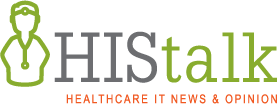News 1/10/24
Top News

Amazon adds Health Conditions Programs to its Health services to help Amazon account holders find and enroll in digital health programs that are covered by their insurance plans.
The online retailer has tapped Omada Health, which offers programs for diabetes prevention, and diabetes and hypertension management, as its launch partner.
The Amazon program will apparently advertise third-party digital health products. It will be interesting to see how insurers react to having their customers pitched to buy digital health services at the insurer’s expense.
Webinars
January 19 (Friday) 1 ET. “Unlocking Reliable Clinical Data: Real-World Success Stories.” Sponsor: DrFirst. Presenters: Alistair Erskine, MD, MBA, CIO/CDO, Emory Healthcare; Jason Hill, MD, MMM, associate CMIO, Ochsner Health; Colin Banas, MD, MHA, chief medical officer, DrFirst. Health system leaders will describe how they are empowering clinicians with reliable patient data while minimizing workflow friction within Epic. They will offer real-world experience and tips on how to deliver the best possible medication history data to clinicians at the point of care, use clinical-grade AI to infer and normalize prescription instructions in Epic, and encourage patient adherence to medication therapies for optimal outcomes.
January 24 (Wednesday) noon ET. “Medication Management Redefined.” Sponsor: DrFirst. Presenters: Nick Barger, PharmD, VP of product, DrFirst; Caleb Dunn, PharmD, MS, senior product manager, DrFirst. Clinical workflow experts will paint a reimagined vision for e-prescribing that offers enhanced patient adherence, customizable clinical support, intelligent pharmacy logic, and data integrity and safety. Join this first chapter of an ongoing conversation about what medication management should be, how to deliver greater benefits today, and how to prepare for the future. Elevating your solution and customer benefits isn’t as hard, scary, or economically challenging as you may think.
Previous webinars are on our YouTube channel. Contact Lorre to present or promote your own.
Acquisitions, Funding, Business, and Stock

Patient navigation software and services vendor Care Continuity raises $10 million.
Impact Advisors acquires payer-focused First Quadrant Advisory.
GE HealthCare will acquire medical imaging analysis software vendor MIM Software.
Medical record retrieval and analysis software startup Credo Health raises $5.25 million. CEO Carm Huntress, founder and former CEO of RxRevu, launched the company nine months ago.
Food and environmental services outsourcer Aramark will offer the hospitalized patients of customers of its clinical nutrition service the ability to connect with its dietitians via the hospital’s preferred telehealth platform.

Harris acquires the Medstreaming vascular and cardiovascular reporting, practice management, and billing solution of Fivos, which Harris will offer under its Picis brand.
Sales
- Tallahassee Memorial HealthCare selects Ensemble Health Partners for revenue cycle management.
- Premier Orthopaedic and Hand Center (IL) selects EHR and patient engagement software from EClinicalWorks.
- VHC Health in Washington, DC will implement RCM software and services from Med-Metrix. Two hundred VHC RCM staff will transition to employment with Med-Metrix as part of the 15-year contract.
- California-based HIE SacValley MedShare selects Health Catalyst’s data and analytics technology and professional services.
People

NextGen promotes Srinivas Velamoor, MBA to president and COO.


Ingeborg “Inge” Garrison, RN, MSN (RLDatix) and Amanda Heidemann, MD (KeyCare) join EVisit as principals of clinical strategy.

Deb Anderson, MBA (Advocate Health) joins Endeavor Health as CIO.

Caleb Hartman (Gozio) joins Loyal as VP of sales.
Announcements and Implementations

Hartford Healthcare (CT) begins offering virtual care at select retail and community locations via OnMed health stations.
Government and Politics
ONC’s HTI-1 final rule is published in the Federal Register with an effective date of February 8. The rule covers algorithm transparency, USCDI Version 3 as a baseline certification standard, enhanced information blocking requirements, and new interoperability-focused reporting metrics for Certified Health IT.
Privacy and Security
Refuah Health Center (NY) will pay $450,000 in penalties and costs and will invest $1.2 million in cybersecurity improvements to settle New York State charges that it failed to protect patient information in a May 2021 ransomware attack. The state says that the hackers gained access to the FQHC’s security cameras that was protected by a static, four-digit code; moved from there to its private network; then used the login credentials of one of its IT vendors that had been unused since 2014 to gain access to its systems.
Other

Withings unveils its BeamO “multiscope.” Designed for use during home-based virtual visits, the device acts as a digital thermometer, electrocardiogram, oximeter, and stethoscope. The company anticipates launching the product and its accompanying app in at select retailers in July for $250.

OhioHealth equips its new Pickerington Methodist Hospital with smart room technology from EVideon.

Healthcare think tank The Lown Institute announces the winners of its 2023 Shkreli Awards:
- Columbia University, for failing to stop the sexual assaults of one of its OB-GYNs despite complaints from 250 patients, with the resulting lawsuit costing it $235 million to settle.
- Non-profit Catholic hospital operator CommonSpirit Health, which paid its CEO $36 million in 2021.
- Drug companies that are challenging a new law that allows Medicare to negotiate drug prices with manufacturers for the first time, which they claim violates their constitutional rights.
- Hospitals that have partnered with private equity firms to offer high-interest medical credit cards.
- A doctor who has been disciplined by 12 state medical boards and settled Medicare fraud allegations related to performing unnecessary procedures who failed a mandated ethics course twice and is still practicing medicine.
- Drugmaker GlaxoSmithKline, which hid evidence that its Zantac heartburn drug caused cancer.
- An Indiana cardiologist who catheterized a single patient 44 times to implant 41 stents.
- Hospitals who were caught dumping homeless patients onto the street.
- A surgeon who implanted two expensive, experimental Medtronic devices into a patient of a hospital that serves mostly low-income patients, after which the patient had a stroke that caused with long-term damage.
- A Pennsylvania hospital that gave the family of an undocumented immigrant 48 hours to pay $500 per day for at-home medical equipment, find a hospital that would accept her transfer, or consent to be medically deported to the Dominican Republic.
Sponsor Updates
- Arcadia joins Atropos Health’s Evidence Network.
- The Thriving Practice Podcast features Arrive Health CEO Kyle Kiser, “On a Mission for Affordable Medications.”
- Clearwater Executive Chairman Bob Chaput releases a new book, “Enterprise Cyber Risk Management as a Value Creator.”
Blog Posts
- Understanding the Changes in the CMS-HCC Model V28 (AGS Health)
- Navigating the Future: Trends Shaping the Recruiting Industry in 2024 (Direct Recruiters)
- Maximizing Efficiency: The Role of AI in Healthcare (DrFirst)
Contacts
Mr. H, Lorre, Jenn, Dr. Jayne.
Get HIStalk updates.
Send news or rumors.
Contact us.


























































Merry Christmas and a Happy New Year to the HIStalk crowd. I wish you the joys of the season!